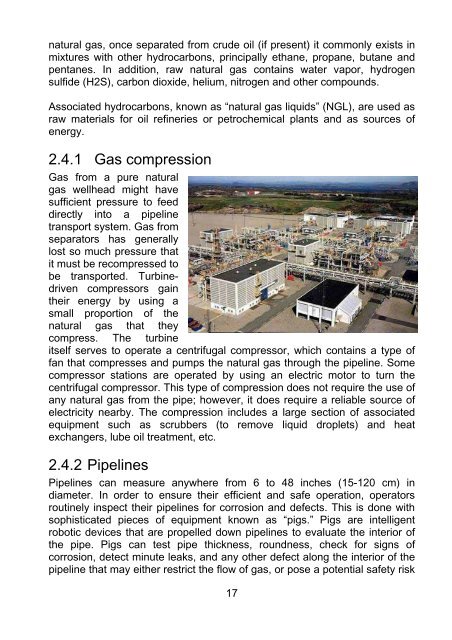Oil and gas production handbook An introduction to oil ... - ABB Group
Oil and gas production handbook An introduction to oil ... - ABB Group
Oil and gas production handbook An introduction to oil ... - ABB Group
You also want an ePaper? Increase the reach of your titles
YUMPU automatically turns print PDFs into web optimized ePapers that Google loves.
natural <strong>gas</strong>, once separated from crude <strong>oil</strong> (if present) it commonly exists in<br />
mixtures with other hydrocarbons, principally ethane, propane, butane <strong>and</strong><br />
pentanes. In addition, raw natural <strong>gas</strong> contains water vapor, hydrogen<br />
sulfide (H2S), carbon dioxide, helium, nitrogen <strong>and</strong> other compounds.<br />
Associated hydrocarbons, known as “natural <strong>gas</strong> liquids” (NGL), are used as<br />
raw materials for <strong>oil</strong> refineries or petrochemical plants <strong>and</strong> as sources of<br />
energy.<br />
2.4.1 Gas compression<br />
Gas from a pure natural<br />
<strong>gas</strong> wellhead might have<br />
sufficient pressure <strong>to</strong> feed<br />
directly in<strong>to</strong> a pipeline<br />
transport system. Gas from<br />
separa<strong>to</strong>rs has generally<br />
lost so much pressure that<br />
it must be recompressed <strong>to</strong><br />
be transported. Turbinedriven<br />
compressors gain<br />
their energy by using a<br />
small proportion of the<br />
natural <strong>gas</strong> that they<br />
compress. The turbine<br />
itself serves <strong>to</strong> operate a centrifugal compressor, which contains a type of<br />
fan that compresses <strong>and</strong> pumps the natural <strong>gas</strong> through the pipeline. Some<br />
compressor stations are operated by using an electric mo<strong>to</strong>r <strong>to</strong> turn the<br />
centrifugal compressor. This type of compression does not require the use of<br />
any natural <strong>gas</strong> from the pipe; however, it does require a reliable source of<br />
electricity nearby. The compression includes a large section of associated<br />
equipment such as scrubbers (<strong>to</strong> remove liquid droplets) <strong>and</strong> heat<br />
exchangers, lube <strong>oil</strong> treatment, etc.<br />
2.4.2 Pipelines<br />
Pipelines can measure anywhere from 6 <strong>to</strong> 48 inches (15-120 cm) in<br />
diameter. In order <strong>to</strong> ensure their efficient <strong>and</strong> safe operation, opera<strong>to</strong>rs<br />
routinely inspect their pipelines for corrosion <strong>and</strong> defects. This is done with<br />
sophisticated pieces of equipment known as “pigs.” Pigs are intelligent<br />
robotic devices that are propelled down pipelines <strong>to</strong> evaluate the interior of<br />
the pipe. Pigs can test pipe thickness, roundness, check for signs of<br />
corrosion, detect minute leaks, <strong>and</strong> any other defect along the interior of the<br />
pipeline that may either restrict the flow of <strong>gas</strong>, or pose a potential safety risk<br />
17

















